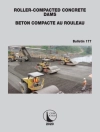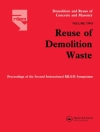This book presents select proceedings of the 17th Symposium on Earthquake Engineering organized by the Department of Earthquake Engineering, Indian Institute of Technology Roorkee. The topics covered in the proceedings include engineering seismology and seismotectonics, earthquake hazard assessment, seismic microzonation and urban planning, dynamic properties of soils and ground response, ground improvement techniques for seismic hazards, computational soil dynamics, dynamic soil–structure interaction, codal provisions on earthquake-resistant design, seismic evaluation and retrofitting of structures, earthquake disaster mitigation and management, and many more. This book also discusses relevant issues related to earthquakes, such as human response and socioeconomic matters, post-earthquake rehabilitation, earthquake engineering education, public awareness, participation and enforcement of building safety laws, and earthquake prediction and early warning system. Thisbook is a valuable reference for researchers and professionals working in the area of earthquake engineering.
Mục lục
Probabilistic Arias Intensity Maps of Uttarakhand State (India).- Statistical Analysis of Completeness Period and Seismicity Parameters of Earthquake Catalogue for Sree Padmanabhaswami Temple, Thiruvananthapuram District, Kerala.- Effects of Open Stories on Expected Seismic Losses in Hilly Buildings.- Influence of Source Offset on the Resolution of Dispersion Image.- Co-seismic Deformation Of Iran, 2021 Earthquake Using DIn SAR Technique.- Three Dimensional Crustal Velocity Structure of Tehri, Garhwal Himalaya.- Correlation Between Cone Tip Resistance and Shear Wave Velocity at Quaternary Alluvium.- Ground Motion Predictive Equations and Its Applicability in North-Eastern Indian Region: A Critical Appraisal.- Influence of Site-city Interaction on the Response of Buildings on Trapezoidal Basin.- Assessment of Double Resonance from Microtremor Observations for Jammu Region in India.- Influence of Epistemic Uncertainty on the Seismic Vulnerability of Indian Code-compliant RC Frame Building.- Spatial Distribution of the Gutenberg-Richter Parameters and Fractal Dimension and Their Correlations in Northeast India and Its Vicinity.- Seismic Hazard Analysis Considering the Effect of the Shape, Size and EQ Distribution of Seismic Sources for Different Locations in Sikkim, NE India.- A Comparative Study on Application of Machine Learning Algorithms in Ground Motion Prediction Equations.- Study of Anomalous Behavior of Atmospheric Parameters- As an Earthquake Precursors for Himalayan Region Earthquakes.- Probabilistic Seismic Hazard Assessment of North East India.- Experimental Investigation of Seismic Response of Hybrid Shear Wall with External Energy Dissipating Reinforcement.- 1D Velocity Model for NW India in and Around Delhi.- Anomalous Deviations in Atmospheric Parameters as Pre-earthquake Signals – A Case Study on Sumatra Region Earthquakes (M-6.0).- Spatial Distribution of Stress Orientation by Inversion of Focal Mechanism Solutions Using MSATSI: A Case Study Across Japan Trench.- Seismic Landslide Hazard Assessment of Mandi Town, Himachal Pradesh.- Infill Wall Effect on Seismic Analysis of Reinforced Concrete Buildings.- Geotechnical Seismic Base Isolation Using Rubber Sand Mixtures – Review.- Development of Soil Amplification Factors Using 1D and 2D Ground Response Analysis.- Probabilistic Seismic Hazard Assessment for Assam, North-East India.- Effect of Randomness of Slip and Source Time Function on Pseudo-dynamically Simulated Ground Motion Characteristics.- Quantification of Ridge-weathering Effects on the Simulated Ground Motion Characteristics Across 2D and 3D Topography Models.- Developing a Comprehensive Historical Tsunami Database for the Indian Ocean.- Seismically Induced Landslide Hazard Analyses for a Road Corridor in the Lower Himalayas.- Assessment Of Proxy-Based Vs30 Estimation in Roorkee, Uttarakhand.- Ground Motion Prediction Equation for NW Himalaya and Its Surrounding Region.- Identification of Strong Motion Generetion Area of the 2019 Hualien Earthquake.- Role of SH Wave in the Mapping of Shallow Subsurface.- A Variational Mode Decomposition Approach for Modal Identification of Structures.- Geo-factor Inference Modelling with Empirical Susceptibility Weights Approach for GIS-based Seismic Hazard Mapping of Thiruvananthapuram City.- GNU-Octave Tool for Probabilistic Seismic Hazard Assessment.- Site Amplification Study Using Strong Motion Data Recorded at Various Stations in India from Far-field Earthquakes.- ROSERS – A Deep Learning Framework for Earthquake Early Warning and its Interpretation.- Early Warning System: An Efficient Earthquake Disaster Mitigation Tool.- Application of Regression Techniques for Preparing a Homogenous Earthquake Catalog – An Overview.- A Cluster-based Seismic Risk Assessment: Economic Loss Using GIS for Jaipur Sub-urban Area.- Modelling of Empirical Accelerograms of 1999 Chamoli Earthquake (Himalaya) Using a Modified Hybrid Approach.- Development and Implementation of a Regional Earthquake Early Warning System in Northern India.- A Critical Review of Existing Building Regulations and Bye-laws in Hilly Regions Of India.- Microseismic Analysis Using Event Count and Potency Displacement for Stability Evaluation of an Underground Cavern.- Characteristics of Strong Ground Motions for Delhi National Capital Region (NCR) Using Small to Moderate Size Earthquakes.- Detection of Liquefaction Phenomenon from the 2015 Nuweiba Earthquake Using Remote Sensing Data.- Estimation of Site Amplification Factor and Predominant Frequency in and Around Panchkula City, Haryana, India.- Use of GIS for Hypsometric Analysis for Determining Erosion Proneness of Mandakini Watershed, Lesser Himalaya, Uttarakhand, North India.- Understanding the Structure and Tectonic Configuration of Bengal Basin for Earthquake Magnitude Prediction.- Exploring an Alternate Perspective of the Importance Factor for Seismic Design of Structures.- Simplified Damping Modification Factor for Vertical Response Spectra.- December 01, 2020, Haridwar, Earthquake: Fault Plane Solution and Tectonic Implications.- Local Seismicity around Tehri Dam, Garhwal Himalaya.
Giới thiệu về tác giả
Dr. Manish Shrikhande is Professor and Head of the Department of Earthquake Engineering at Indian Institute of Technology Roorkee. His current research interests are vibration monitoring and control, seismic risk and mitigation, and computational mechanics.
Dr. Pankaj Agarwal is Professor at the Department of Earthquake Engineering, Indian Institute of Technology Roorkee. His research interests are earthquake-resistant design of masonry and RC structures, post-damage assessment survey of earthquake-affected areas, risk assessment, cyclic testing of structures, seismic instrumentation in multi-storied buildings, health monitoring, and damage detection in buildings. He is continuously engaged in research on structurally sound and seismically efficient construction and has published several research papers in national and international journals and conferences/seminars/symposia.
Dr. P. C. Ashwin Kumar is Assistant Professor at the Departmentof Earthquake Engineering, Indian Institute of Technology Roorkee. He has been engaged in teaching and research in earthquake-resistant design of steel structures, development of passive devices for seismic protection, vulnerability assessment, and retrofitting of structures.












